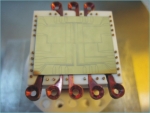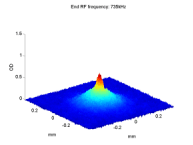Anisotropic Materials
Close to a surface, the main source of atom loss is surface noise-induced spin-flips. If the surface is made from an electrically anisotropic material, the components of the magnetic-field's noise power spectrum change differently depending on the direction of the anisotropic material axes. By selecting a good conductivity axis of the anisotropic material in the direction of the Ioffe-Pritchard (IP) field of the magnetic trap (i.e. the direction of the atoms' polarization) and bad conductivity axes in the perpendicular directions we make one of the perpendicular components of the magnetic field's noise lower, causing a lower loss rate (the spin-flips loss rate depends on the perpendicular components of the noise spectrum). Rotating the material by 90 degrees will put the good conductivity axis in a direction perpendicular to the IP field making the perpendicular component of the magnetic field's noise higher and causing a higher loss rate.
In our experiment we plan to place 4 pieces of a highly anisotropic material on an atom chip. Each piece will be put with its good conductivity axis at a different angle with respect to the IP field of our trap. The expected dependence of the cloud's life time on the orientation of the anisotropic material is shown in the graph below (left). On the right side an illustrative image of the cold atomic cloud above two anisotropic materials on an atom chip is shown.

Full size image |

Full size image |
For more information see "Magnetic interactions of cold atoms with anisotropic conductors" in Papers, and Tal David Thesis.

